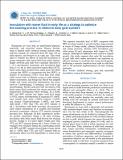Por favor, use este identificador para citar o enlazar a este item:
http://hdl.handle.net/10261/216247COMPARTIR / EXPORTAR:
 SHARE SHARE
 CORE
BASE CORE
BASE
|
|
| Visualizar otros formatos: MARC | Dublin Core | RDF | ORE | MODS | METS | DIDL | DATACITE | |

| Título: | Inoculation with rumen fluid in early life as a strategy to optimize the weaning process in intensive dairy goat systems |
Autor: | Belanche, A. CSIC ORCID; Palma-Hidalgo, Juan Manuel CSIC ORCID; Nejjam, I.; Jiménez, E.; Martín García, A. Ignacio CSIC ORCID; Yáñez Ruiz, David R. CSIC ORCID | Palabras clave: | Artificial rearing Goat kid Microbial inoculation Rumen development Weaning |
Fecha de publicación: | 2020 | Editor: | American Dairy Science Association | Citación: | Journal of Dairy Science 103: 5047- 5060 (2020) | Resumen: | Ruminants are born with an undeveloped physical, metabolic, and microbial rumen. Rumen development is limited under artificial rearing systems when newborn animals are separated from the dam, fed on milk replacer, and weaned at an early age. This study aims to evaluate the effects of early-life inoculation of young ruminants with rumen fluid from adult animals. Eighty newborn goat kids were randomly allocated to 1 of 4 experimental treatments and inoculated daily from d 1 to wk 11 with autoclaved rumen fluid (AUT), fresh rumen fluid obtained from adult goats fed either a forage diet (RFF) or concentrate-rich diet (RFC), or absence of inoculation (CTL). Goat kids were artificially reared with ad libitum access to milk replacer, starter concentrate, and forage hay. Blood was sampled weekly and rumen microbial fermentation was monitored at 5 (preweaning), 7 (weaning), and 9 wk of age (postweaning). Results indicated that inoculation with fresh rumen fluid accelerated the rumen microbial and fermentative development before weaning. As a result, RFC and RFF animals had higher solid feed intake (+73%), rumen concentrations of ammonia-N (+26%), total volatile fatty acids (+46%), butyrate (+50%), and plasma β-hydroxybutyrate (+48%), and lower milk intake (−6%) than CTL and AUT animals at wk 5. Inoculation with fresh inoculum also promoted early rumen colonization by a complex and abundant protozoal community, whereas CTL animals remained protozoa free. Although all kids experienced moderate growth retardation during 1 wk after weaning, inoculation with fresh rumen fluid favored the weaning process, leading to 2.2 times higher weight gain than CTL and AUT animals during wk 8. Some of these advantages were retained during the postweaning period and RFF and RFC animals showed higher forage intake (up to +44%) than CTL and AUT animals with no detrimental effects on feed digestibility or stress levels. The superior microbial load of RFC compared with RFF inoculum tended to provide further improvements in terms of forage intake, plasma β-hydroxybutyrate, and rumen protozoa, whereas AUT inoculation provided minor (if any) advantages with respect to CTL animals. Although no differences were noted on animal growth, this study suggests that early life inoculation of goat kids with rumen microbiota can represent an effective strategy to accelerate the rumen development, facilitating a smooth transition from milk to solid feed and to the potential implementation of early weaning strategies. | Versión del editor: | http://dx.doi.org/10.3168/jds.2019-18002 | URI: | http://hdl.handle.net/10261/216247 | DOI: | 10.3168/jds.2019-18002 | Identificadores: | doi: 10.3168/jds.2019-18002 issn: 1525-3198 |
| Aparece en las colecciones: | (EEZ) Artículos |
Ficheros en este ítem:
| Fichero | Descripción | Tamaño | Formato | |
|---|---|---|---|---|
| 2020_Belanche_JDS_OA.pdf | 691,42 kB | Adobe PDF |  Visualizar/Abrir |
CORE Recommender
SCOPUSTM
Citations
26
checked on 17-abr-2024
WEB OF SCIENCETM
Citations
27
checked on 21-feb-2024
Page view(s)
132
checked on 19-abr-2024
Download(s)
177
checked on 19-abr-2024
Google ScholarTM
Check
Altmetric
Altmetric
Este item está licenciado bajo una Licencia Creative Commons

